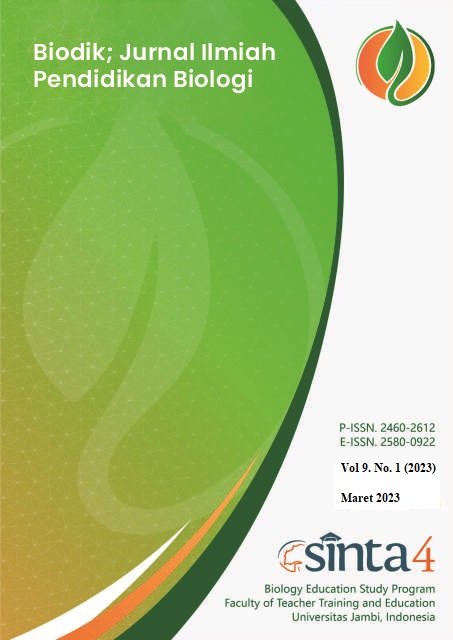Penerapan Model Pembelajaran Kooperatif Tipe Jigsaw Untuk Meningkatkan Hasil Belajar Siswa SMA Kelas X IPA Dharma Wanita Persatuan Pemprovsu Tahun 2022
(Application of the Jigsaw Cooperative Learning Model to Improve Student Learning Outcomes in Class X IPA Dharma Wanita Pemprovsu Association in 2022)
DOI:
https://doi.org/10.22437/bio.v9i1.19169Abstract
The objectives of this Classroom Action Research were to: 1) Improve student learning outcomes at the Dharma Wanita Association of North Sumatra Provincial Government 2) Improve students' abilities with the jiksaw type cooperative learning model. To achieve this goal, the study was designed in two cycles. The procedure for each cycle includes: 1) development of a problem focus, 2) planning of corrective actions, 3) implementation of actions, observations, and interpretations. The effectiveness of the actions in each cycle is measured from the results of observations and the results of the pretest and posttest abilities. Observational data in cycle I were described and interpreted and then reflected to determine corrective actions in cycle II. While the data in the form of pretest and posttest ability test results were analyzed by describing and comparing test scores in the initial conditions, cycle I, and cycle II. The completion limit that must be achieved by students in cycle II, namely: 100% of students are able to answer all pretest and posttest questions with a maximum of 2) all students achieve a maximum score of 80. Class Action Research regarding student activities while participating in learning, the results obtained were that classical completeness was 70% in the initial conditions, 70% in the first cycle, and 80% in the second cycle. Based on the results of this Classroom Action Research, it can be concluded that: The Application of the Jigsaw Type Cooperative Learning Model in the Ecosystem Concept to Improve Student Learning Outcomes at the North Sumatra Provincial Government's Dharma Wanita Association High School. Can improve learning outcomes and can change student learning patterns.
Abstrak. Tujuan Penelitian Tindakan Kelas ini adalah untuk: 1) Meningkatkan hasil belajar Siswa SMA Dharma Wanita Persatuan pemprovsu 2) Meningkatkan kemampuan siswa dengan model pembelajaran kooperatif tipe jiksaw.Untuk mencapai tujuan, tersebut, penelitian didesain dalam dua siklus. Prosedur pada setiap siklus, mencakup tiap-tiap: 1) pengembangan fokus masalah, 2) perencanaan tindakan perbaikan, 3) pelaksanaan tindakan, observasi, dan interpretasi, Keefektifan tindakan pada setiap siklus diukur dari hasil observasi dan hasil tes kemampuan pretest dan postest. Data hasil observasi pada siklus I, dideskripsikan dan diinterpretasikan kemudian direfleksi untuk menentukan tindakan perbaikan pada siklus II. Sedangkan data yang berupa hasil tes kemampuan pretest dan post tes dianalisis dengan cara mendeskripsikan dan membandingkan nilai tes pada kondisi awal, siklus I, dan siklus II. Batas tuntas yang harus dicapai siswa pada siklus II, yakni: 100% siswa mampu menjawab semua soal pretest dan postest dengan maksimal 2)semua siswa siswi mencapai nilai yang maksimal yaitu80. Penelitian Tindakan Kelas mengenai aktivitas siswa selama mengikuti pembelajaran, diperoleh hasil bahwa ketuntasan secara klasikal pada kondisi awal sebesar 70%, pada siklus I sebesarg 70%, dan pada siklus II sebesar 80%. Berdasarkan hasil Penelitian Tindakan Kelas tersebut, dapat disimpulkan bahwa: Penerapan Model Pembelajaran Kooperatif Tipe Jigsaw Pada Konsep Ekosistem untuk Meningkatkan Hasil Belajar Siswa SMA Dharma Wanita Persatuan pemprovsu. Dapat meningkatkan hasil belajar dan dapat mengubah pola pembelajaran siswa.
Downloads
References
Sumantri Moh. Syarifi. 2015. Strategi Pembelajaran (Kota Depok:PT Rajagrafindo).
Jihad, Asep & Haris, Abdul. 2013. Evaluasi Pembelajaran (Yogyakarta : Multi pressindo,).
Sanjaya, Wina. 2011. Strategi Pembelajaran Berorientasi Standar Proses Pendidikan (Jakarta: PrenadaMedia).
Ruman. 2014. Model-Model Pembelajaran (Jakarta: PT. Rajagrafindo). Suyono , 2011 Belajar dan Pembelajaran. Bandung : Remaja Rosdakarya.
Uno, Hamzah. 2010.Teori Motivasi dan Pengukurannya. Jakarta : Bumi Aksara. Nasution, S. 1990. Berbagai Pendekatan dalam Proses Belajar-Mengajar (Jakarta: Bina Aksara).
Hamalik Oemar. 2006. Proses Belajar Mengajar (Bandung: Bumi Aksara). Winkel,W.S. 1987. Psikologi Pengajaran (Jakarta : Gramedia).
Sudjana, Nana dan Ahmad Rivai. 2011. Media Pengajaran (Bandung: Sinar Baru Algensindo).
Margaret E. 1991. Bell Gredler, Learning and Instruction Theory into Practice. Terjemahan Munandir (Jakarta: Rajawali).
Daryanto. 2007. Evaluasi Pendidikan (Jakarta:Rineka Cipta).
Nana Sudjana. 2009. Penilaian Hasil Proses Belajar Mengajar, (Bandung: PT Remaja Rosdakarya).
Iif Khoiri Ahmadi, dkk. 2011. Strategi Pembelajaran Berorientasi KTSP, (Jakarta: Prestasi PustakaPublisher).
Asep Jihad-Abdul Haris, Evaluasi Pembelajaran, (Jakarta: Multi Press).
Downloads
Published
How to Cite
Issue
Section
License
Copyright (c) 2022 Dewi Yulika Harahap , Lidyah Rahmayani, Putri Bungsu Berutu, Indayana Febriyani Tanjung

This work is licensed under a Creative Commons Attribution-NonCommercial-ShareAlike 4.0 International License.
Copyright Notice
Authors who publish with Biodik : Jurnal Ilmiah Pendidikan Biologi agree to the following terms:
- For all articles published in Biodik : Jurnal Ilmiah Pendidikan Biologi, copyright is retained by the authors and grant the journal right of first publication with the work simultaneously licensed under a Creative Commons Attribution-ShareAlike 4.0 International Licensethat allows others to share the work with an acknowledgment of the work's authorship and initial publication in this journal.
- Authors are able to enter into separate, additional contractual arrangements for the non-exclusive distribution of the journal's published version of the work (e.g., post it to an institutional repository or publish it in a book), with an acknowledgment of its initial publication in this journal.
- Authors are permitted and encouraged to post their work online (e.g., in institutional repositories or on their website) prior to and during the submission process, as it can lead to productive exchanges, as well as earlier and greater citation of published work (See The Effect of Open Access).

















